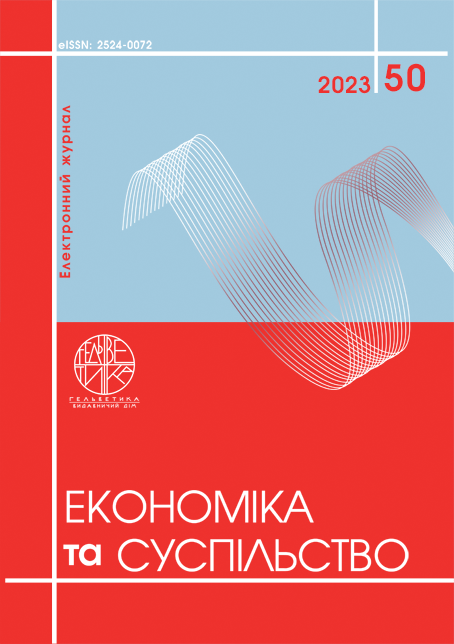DRIVERS OF TOURISM INDUSTRY DEVELOPMENT IN MODERN CONDITIONS
Abstract
The paper studies the drivers of the development of the tourism industry in modern conditions. It has been established that tourism is one of the most highly profitable and intensively developing branches of the world economy. It found that international tourist flows are gradually increasing, with over 900 million tourists making international trips in 2022, double the number in 2021, but only 63% of the pre-pandemic level, according to UNWTO data. The COVID-19 pandemic is set to create unprecedented challenges for the global travel and tourism market in 2020 and 2021, as countries around the world have imposed travel restrictions and bans to contain the spread of infections. In 2021, the United States was found to have the highest contribution from travel and tourism to GDP, with these industries directly or indirectly contributing approximately $1.27 trillion, followed by China and Germany, where the total contribution of travel and tourism to GDP amounted to 814 billion and 251 billion US dollars, respectively. It was found that the main drivers of the development of the tourism industry in modern conditions include: an increase in the flow of direct foreign investments in the country; improvement of infrastructure and accommodation facilities; socio-economic, cultural, demographic, material, technical and political drivers; increase in tourist demand; use of modern technological innovations; change in demand and expectations of tourists; growing competition in the tourism industry and globalization; legislative and regulatory changes. It has been established that the large-scale application of information technologies is a prerequisite for the digital economy to stimulate the development of tourism, promote the development and implementation of tourism innovations, and in turn affect changes in the relationship between producers and consumers of tourism. Social networking websites have been found to play an important role in the tourism industry, as tourists use these platforms to share online content related to their travels, and companies and influencers use them as a marketing tool, offering vacation spots and promoting differentiated tourism products.
References
Журба І., Несторишен І. Аналіз показників індустрії туризму в Україні та світі: проблеми та перспективи розвитку. Development Service Industry Management. 2023. № 1. С. 50–55. DOI: https://doi.org/10.31891/dsim-2023-1(5)
UNWTO. Tourism set to return to pre-pandemic levels in some regions in 2023. 2023. URL: https://www.unwto.org/news/tourism-set-to-return-to-pre-pandemic-levels-in-some-regions-in-2023
World Travel & Tourism Council. 2023. URL: https://www.wttc.org/
Number of international tourist arrivals worldwide from 2005 to 2022, by region. Statista. 2023. URL: https://www.statista.com/statistics/186743/international-tourist-arrivals-worldwide-by-region-since-2010/
Top travel markets by tourism GDP worldwide 2021. Statista. 2022. URL: https://www.statista.com/aboutus/our-research-commitment
Nidhi K. Top factors that drive growth in tourism market. ProMiller Team. 2022. URL: https://www.promiller.in/post/top-factors-that-drive-growth-in-tourism-market
Marino A., Pariso P. E-tourism: How ICTs help the local tourist district drive economic vitality. The case of Campania, Italy. International Journal of Innovation and Technology Management, 2021, 18(03), 2150009. DOI: https://doi.org/10.1142/S0219877021500097
Rui T. Digital economy drives tourism development—empirical evidence based on the UK. Economic Research-Ekonomska Istraživanja, 2023, vol. 36:1, рр. 2003-2020. DOI: https://doi.org/10.1080/1331677X.2022.2094443
Jiang X. Digital economy in the post-pandemic era. Journal of Chinese Economic and Business Studies, 2021, vol. (3), рр. 1–7.
Laakkonen M. P., Kivivirta V. Customer value of smart grid application: Implications for E-Service design in smart cities. International Journal of Innovation in the Digital Economy, 2021, vol. 12(1), рр. 27–41. DOI: https://doi.org/10.4018/IJIDE.2021010102
Digitalization of the travel industry – statistics & facts_Statista. 2022. URL: https://www.statista.com/
Market cap of leading online travel companies worldwide as of December 2022. Statista. 2023. URL: https://www.statista.com/statistics/1039616/leading-online-travel-companies-by-market-cap/
Tourism Marketing: Your Guide to Success Within The Tourism Industry. Profiletree. 2022. URL: https://profiletree.com/tourism-marketing-strategies/
Zhurba, I., Nestoryshen, I. (2023). Analiz pokaznykiv industrii turyzmu v Ukraini ta sviti: problemy ta perspektyvy rozvytku. [Analysis of indicators of the tourism industry in Ukraine and the world: problems and development prospects]. Development Service Industry Management, vol. (1), pp. 50–55. DOI: https://doi.org/10.31891/dsim-2023-1(5) [in Ukrainian]
UNWTO. (2023). Tourism set to return to pre-pandemic levels in some regions in 2023. Available at: https://www.unwto.org/news/tourism-set-to-return-to-pre-pandemic-levels-in-some-regions-in-2023
World Travel & Tourism Council. (2023). Available at: https://www.wttc.org/
Statista. (2023). Number of international tourist arrivals worldwide from 2005 to 2022, by region. Available at: https://www.statista.com/statistics/186743/international-tourist-arrivals-worldwide-by-region-since-2010/
Statista. (2022). Top travel markets by tourism GDP worldwide 2021. Available at: https://www.statista.com/aboutus/our-research-commitment
Nidhi, K. (2022). Top factors that drive growth in tourism market. ProMiller Team. Available at: https://www.promiller.in/post/top-factors-that-drive-growth-in-tourism-market
Marino, A., Pariso, P. (2021). E-tourism: How ICTs help the local tourist district drive economic vitality. The case of Campania, Italy. International Journal of Innovation and Technology Management, vol. 18(03), 2150009. DOI: https://doi.org/10.1142/S0219877021500097
Rui, T. (2023). Digital economy drives tourism development – empirical evidence based on the UK. Economic Research-Ekonomska Istraživanja, vol. 36:1, рр. 2003-2020. DOI: https://doi.org/10.1080/1331677X.2022.2094443
Jiang, X. (2021). Digital economy in the post-pandemic era. Journal of Chinese Economic and Business Studies, vol. (3), рр. 1–7.
Laakkonen, M. P., Kivivirta, V. (2021). Customer value of smart grid application: Implications for E-Service design in smart cities. International Journal of Innovation in the Digital Economy, vol. 12(1), рр. 27–41. DOI: https://doi.org/10.4018/IJIDE.2021010102
Statista. (2022). Digitalization of the travel industry – statistics & facts_Statista. Available at: https://www.statista.com/
Statista. (2023). Market cap of leading online travel companies worldwide as of December 2022. Available at: https://www.statista.com/statistics/1039616/leading-online-travel-companies-by-market-cap/
Tourism Marketing: Your Guide to Success Within The Tourism Industry. (2022). Profiletree. Available at: https://profiletree.com/tourism-marketing-strategies/

This work is licensed under a Creative Commons Attribution 4.0 International License.


